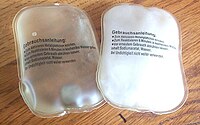
Photo from wikipedia
Abstract We have identified cellulose solvents, comprised of binary mixtures of molecular solvents and ionic liquids that rapidly dissolve cellulose to high concentration and show upper‐critical solution temperature (UCST)‐like thermodynamic… Click to show full abstract
Abstract We have identified cellulose solvents, comprised of binary mixtures of molecular solvents and ionic liquids that rapidly dissolve cellulose to high concentration and show upper‐critical solution temperature (UCST)‐like thermodynamic behaviour ‐ upon cooling and micro phase‐separation to roughly spherical microparticle particle‐gel mixtures. This is a result of an entropy‐dominant process, controllable by changing temperature, with an overall exothermic regeneration step. However, the initial dissolution of cellulose in this system, from the majority cellulose I allomorph upon increasing temperature, is also exothermic. The mixtures essentially act as ‘thermo‐switchable’ gels. Upon initial dissolution and cooling, micro‐scaled spherical particles are formed, the formation onset and size of which are dependent on the presence of traces of water. Wide‐angle X‐ray scattering (WAXS) and 13C cross‐polarisation magic‐angle spinning (CP‐MAS) NMR spectroscopy have identified that the cellulose micro phase‐separates with no remaining cellulose I allomorph and eventually forms a proportion of the cellulose II allomorph after water washing and drying. The rheological properties of these solutions demonstrate the possibility of a new type of cellulose processing, whereby morphology can be influenced by changing temperature.
Journal Title: Chemphyschem
Year Published: 2022
Link to full text (if available)
Share on Social Media: Sign Up to like & get
recommendations!